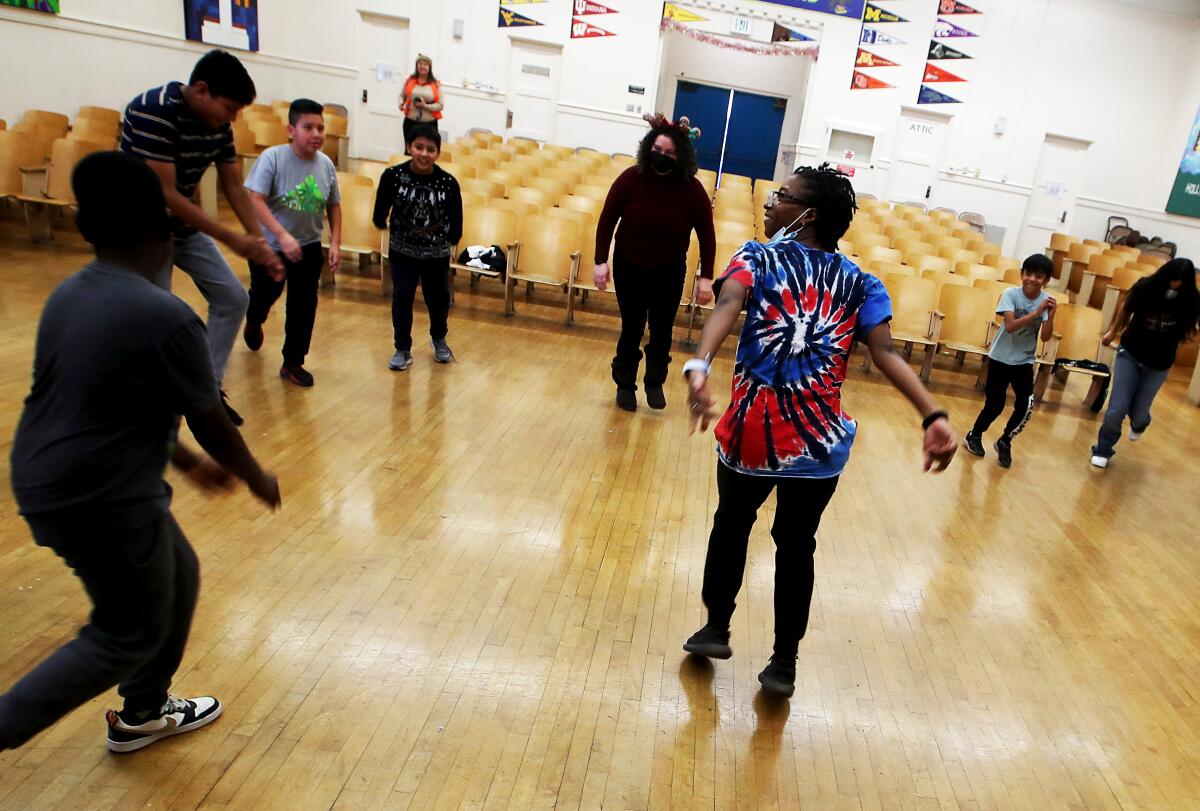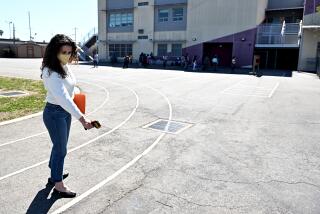LAUSD approves $18.4-billion budget amid concerns over police, the arts and the future

The Los Angeles Board of Education on Tuesday unanimously approved an $18.4-billion spending plan for the next school year, a smaller budget than the previous year, but one that maintains large reserves, preserves essential programs and avoids layoffs.
The new budget is about $600 million less than last year’s approved $19-billion spending plan for the nation’s second-largest school system.
For parents and workers, the big picture is that L.A. Unified school services and staffing for next year will look a lot like last year. But there are important developments related to arts programs, school police, job protections and future financial stability.
How did L.A. Unified avoid layoffs?
Like other school systems, L.A. Unified has had to deal with the end of pandemic-relief aid that paid for staff and extra recovery programs. And a state budget crunch has resulted in lower government funding than anticipated.
It has helped that L.A. Unified received a nearly $500-million boost this school year through federal reimbursement for its comprehensive COVID-testing program.
The massive and hugely expensive program — which required all students and employees to take a weekly COVID test — was among the strictest in the nation and enacted under then-Supt. Austin Beutner. The district initially used its own dollars and reimbursement from the Biden administration was not guaranteed.
The bottom line also benefited because the district never hired hundreds, maybe thousands, of people it had hoped to bring on using pandemic relief aid, including mental health workers, nurses and counselors. Although students lost out on support for academic and mental health needs, money was saved — and, in the aftermath, the district is left with fewer no-longer-funded employees.
The district budget is also lower because funding is based largely on enrollment, and L.A. Unified’s declining enrollment translates to fewer total dollars, even if the amount per student is comparable or increased slightly.
In the budget, the projected enrollment is 403,453 for the next school year. According to budget documents, this figure will represent a decline of 8,888 students from 412,341 in the just-ended school year.
The district’s own published enrollment figures varied considerably this week on its website. This week’s version of the district’s “fingertip facts” put transitional kindergarten through 12th-grade enrollment for last year at 420,454. The district’s “open data” portal this week put this figure at 419,749.
The budget for next year assumes that an average of 92% of enrolled students will be in school on a given day.
What is being cut?
Senior officials say no services to students are being cut and no full-time employees are losing employment and benefits — although some people are changing jobs and making less money. The ranks of assistant principals who managed services to disabled students are being substantially thinned, although these administrators are not being laid off from district employment.
Other school districts have not been so fortunate.
Early on, L.A. Unified administrators searched out additional ways to cut back.
For example, when school budgets came out for the 2024-25 year, the district left principals with less funding than expected. So while senior officials talked publicly of no layoffs, principals were left with the task of cutting nonteaching positions, forcing these staff members into lower-paid jobs or cutting worker hours below the minimum needed to qualify for health benefits.
A mini-furor ensued — led by unions, parents and school staff — and the district has since restored much of the funding. Principals have had to readjust quickly.
What education programs are getting the biggest support?
The budget is a complex document — with money streaming in or drying up from sources with different spending rules. So, while a group of social workers has been transferred to lower-paid positions, there is other funding that can and is being used to rapidly expand robotics programs. And state funding for out-of-school learning has led to a huge bump in field trips.
But in the main, the district’s priorities and spending are more of the same: There is continued strong support for the Black Student Achievement Plan and for schools that are struggling the most academically and that have the students with the highest needs.
Advocates for both these efforts would have liked even more resources for these programs — and told the school board as much in public testimony.
What does the future look like?
The school system will close the year on June 30 with an ending balance of well over $6 billion, a figure that unions categorize as ridiculously high, saying far more money should be spent on additional staff, higher salaries and programs for students.
Officials, however, insist that this amount is misleading and that a different and more relevant figure, the unassigned ending balance, is a comparatively modest $800 million. And that this amount will continue to shrink as the district is already committed to spending far more than is coming in over the next three years.
In this light, district actions reflect concern for the future — which supporters see as prudent and critics as overcautious.
The future concerns include an uncertain state economy and unfunded retiree health benefits. There are approximately 37,220 district retirees covered by post-retirement benefits with a cost in 2023-24 of about $331.8 million.
Does the budget settle a dispute over arts funding?
Not really. Former Supt. Beutner accuses L.A. Unified of violating voter-approved Proposition 28 — which he wrote and which provides new arts funding for every public school in California, with even more dollars for schools with a higher poverty enrollment.
That infusion for arts instruction was supposed to begin in the 2023-24 school year. Under the rules, the new money had to be added to arts instruction funding on top of what a school already was providing. But L.A. Unified parents and staff noticed no change in the level of arts instruction at many schools.
Last week, facing increasing pressure from parents and a coalition that included major unions and Beutner, the district added $30 million to elementary arts programs for next year.
But critics want to know what happened to last year’s money — Proposition 28 sent about $77 million to L.A. Unified last year.
Officials have refused to answer questions from The Times about the level of district-provided funding to elementary school arts instruction — called the itinerant arts program — for 2022-23, 2023-24 and 2024-25. The answer could go a long way toward answering whether the district used Proposition 28 funds to replace district funds, which Beutner and others contend would violate the law.
How was the issue of funding or eliminating school police settled?
It wasn’t.
Anti-police activists, including students, want the school police department eliminated. Last year, its budget was $69.2 million. This year the budget is the same, although given rising costs, a steady year-to-year figure typically represents a cut in services or personnel. Also, $3.7 million in funds from last year’s unfilled police department positions was swept into student services that the anti-police advocates support.
Meanwhile, pro-police parents support increased funding that would return officers to campuses. The board of education voted 4 to 3 in 2020 to cut the school police budget by 35% after the police killing of George Floyd in Minneapolis. Before that action, high schools typically had one officer while two middle schools shared an officer.
More to Read
Sign up for Essential California
The most important California stories and recommendations in your inbox every morning.
You may occasionally receive promotional content from the Los Angeles Times.











